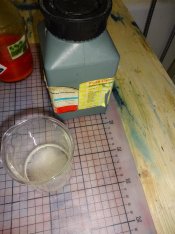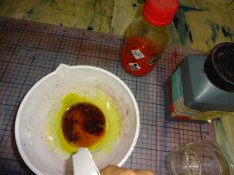If there is excess ascorbic acid or sodium ascorbate, does that guarantee complete conversion to trivalent chromium?
How do you know that the reaction is complete?
Is trivalent chromium safe to put into Steve's septic system?
IMHO there are still a few questions....
Yes, the excess of ascorbic acid shifts the wohle thing (reduction) to the side of the trivalent chromium.
Under different circumstances the other way (oxidation) from Cr(III) to Cr(VI)is possible e.g.
https://www.ncbi.nlm.nih.gov/pubmed/17980482 or
https://www.ncbi.nlm.nih.gov/pubmed/21105643
According to this abstract this oxidation reaction Cr(III) to Cr(VI) is not so unlikely: [...]Because reduced Cr has been considered to be the stable form in soils, we were surprised to find that added trivalent Cr oxidizes readily to the hexavalent form under conditions prevalent in many field soils. The key to the oxidation appears to be the presence in the soil of oxidized Mn, which serves as the electron acceptor in the reaction. The relative ability of a soil to oxidize Cr may be predicted by measuring Mn reducible by hydroquinone, or it may be determined directly by means of a quick test in which Cr(III) is added to a fresh moist soil sample.
Oxidation of Cr by soils was not discovered earlier because the importance of studying fresh field soils, rather than crushed, dried, stored samples, was not appreciated. Plants were severely damaged by Cr(VI) formed from Cr(III) added to fresh soil samples. Hexavalent Cr still was present in a soil stored moist at 25°C for 5 mo.
[...]
Completeness of the reaction: There are colorimetric test kits available see e.g.
http://www.hannacan.com/PDF/manHI3846.pdf but the simplest method is time and color (if the solution as no other color e.g. from dyes). See
http://www.largeformatphotography.i...te-Treatment&p=1332149&viewfull=1#post1332149 where I have done a experiment with 10 L of water, where I have added a few grains of potassium dichromate. The water was slight yellowish and the addition of 10 g ascorbic acid removed the color completely.
"Steve's septic system": No (my opinion)... first accumulation of "heavy metals" should be avoided and second (the main reason) there is the possibility that Cr(III) is converted to Cr(VI) back...so if you put somewhere
soluble Cr(III) in the environment, than it is very likely that you can measure Cr(VI) after a while. Even if there is more or less a anaerobic surrounding and so the oxidation is very unlikely, I would not join this risk, because the stuff will migrate to other places where it can get oxidized.
On the other hand there will be a very big diluting effect...here in the EU there are "generic concentration limits" for carcinogenic substances see:
3.6.3.1.1 and Table 3.6.2 in
https://eur-lex.europa.eu/legal-content/EN/TXT/HTML/?uri=CELEX:32008R1272&from=en
In short: if the concentration of Cr(VI) in a mixture is lower as 0.1% the whole mixture has not to be classified as carcinogenic....so at that conclusion it´s likely that the amount what you use have not this impact. But there is the risk of accumulation....
Bj68








